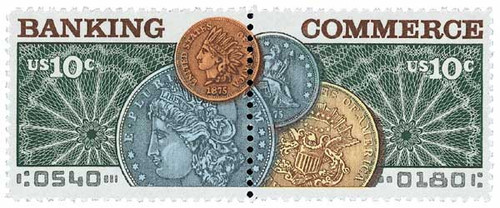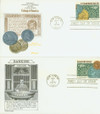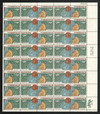
# 1577-78 - 1975 10c Banking and Commerce
Federal Reserve Established
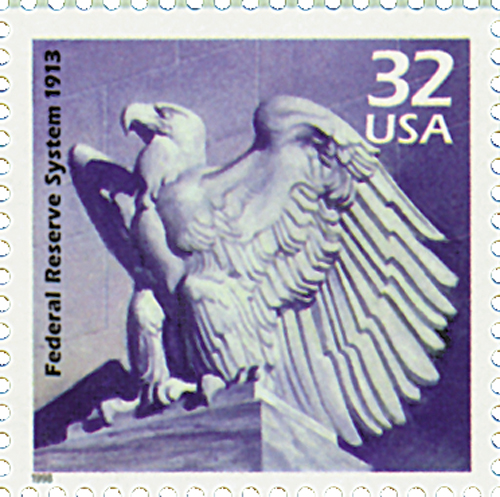
On December 23, 1913, President Woodrow Wilson signed the Federal Reserve Act, establishing America’s current central banking system.
The idea of a central banking system dates back to post-Revolutionary War America. The new country had large wartime debts and needed a solid banking system. Two of America’s founding fathers and long-time friends, Alexander Hamilton and Thomas Jefferson, were split on the issue.
Hamilton believed the US should adopt a national bank, similar to European nations, but Jefferson thought that would threaten democracy. Jefferson also believed it would benefit the North but hurt the South, who received credit from local banks after the war.
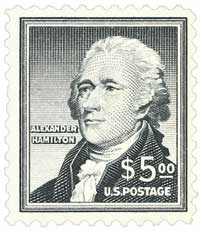
In the end, Hamilton won and the First Bank of the United States was established in 1791. Chartered for 20 years, the bank did successfully help the economy, but it failed to be renewed by one vote in 1811. The Second Bank of the United States was established in 1816, also for a period of 20 years. It was largely unpopular in the west and south and became a private bank when its charter expired in 1836.
For over 75 years, America didn’t have a central bank. During that time there were several financial panics that led some to believe that banking reform was needed. In 1912, the National Monetary Commission submitted the Aldrich Plan (named for its chairman, Nelson W. Aldrich), which called for the creation of a National Reserve Association. This association would provide emergency loans to member banks, produce money, and serve as the government’s fiscal agent.
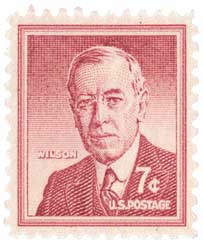
During the election of 1912, Democratic candidate Woodrow Wilson included plans for banking and currency reform on his platform. After he was elected and entered the White House, he made this reform one of his top priorities. He sought to find a middle ground between the needs of the conservative Republicans and the left-wing Democrats. The act was introduced to the house in August 1913 and signed into law by President Wilson that December 23.
The Federal Reserve Act of 1913 gave private banks control of the 12 regional Federal Reserve Banks but placed controlling interest in a central board selected by the president, with Senate approval. The plan went into effect in 1915, later playing a major role in financing the Allied and American war efforts.
The Federal Reserve Act set the framework and guidelines for the nation’s banks, credit, and money supply that we still use today. Commonly known as the “Fed,” this independent governmental agency manages the country’s supply of money and credit. The Fed also provides various financial services for the federal government and the banking system and issues our paper money.
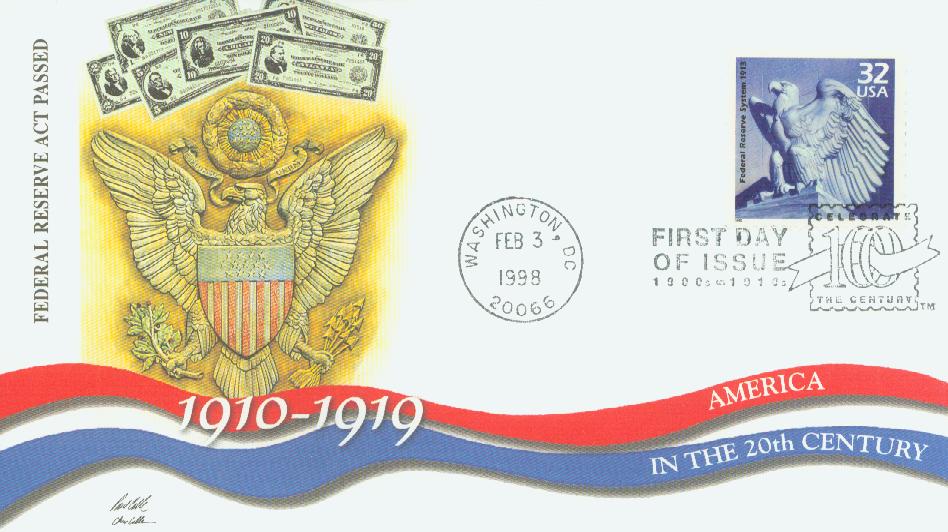
Congress created the Fed to provide a flexible currency for the nation and to supervise the banking system. It controls the flow of money and credit in three ways: through open-market operations, the sale or purchase of government securities; by changing reserve requirements, the percentages of deposits that most banks must set aside before funds are made available for loans; and by changing the discount rate, the interest rate banks pay the Federal Reserve Bank when they borrow money.
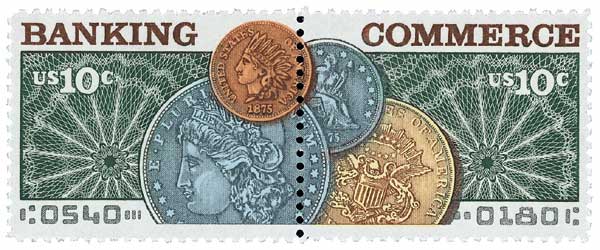
The Fed operates with a great deal of autonomy. It does not rely on Congress for funding – operating expenses are collected from investment income and fees for its services. Although the Fed reports to Congress, it is legally free to make its own policy decisions. The Fed has promoted nationwide economic stability by working to keep interest rates low during recessions and letting them rise during periods of economic growth.
Federal Reserve Established

On December 23, 1913, President Woodrow Wilson signed the Federal Reserve Act, establishing America’s current central banking system.
The idea of a central banking system dates back to post-Revolutionary War America. The new country had large wartime debts and needed a solid banking system. Two of America’s founding fathers and long-time friends, Alexander Hamilton and Thomas Jefferson, were split on the issue.
Hamilton believed the US should adopt a national bank, similar to European nations, but Jefferson thought that would threaten democracy. Jefferson also believed it would benefit the North but hurt the South, who received credit from local banks after the war.

In the end, Hamilton won and the First Bank of the United States was established in 1791. Chartered for 20 years, the bank did successfully help the economy, but it failed to be renewed by one vote in 1811. The Second Bank of the United States was established in 1816, also for a period of 20 years. It was largely unpopular in the west and south and became a private bank when its charter expired in 1836.
For over 75 years, America didn’t have a central bank. During that time there were several financial panics that led some to believe that banking reform was needed. In 1912, the National Monetary Commission submitted the Aldrich Plan (named for its chairman, Nelson W. Aldrich), which called for the creation of a National Reserve Association. This association would provide emergency loans to member banks, produce money, and serve as the government’s fiscal agent.

During the election of 1912, Democratic candidate Woodrow Wilson included plans for banking and currency reform on his platform. After he was elected and entered the White House, he made this reform one of his top priorities. He sought to find a middle ground between the needs of the conservative Republicans and the left-wing Democrats. The act was introduced to the house in August 1913 and signed into law by President Wilson that December 23.
The Federal Reserve Act of 1913 gave private banks control of the 12 regional Federal Reserve Banks but placed controlling interest in a central board selected by the president, with Senate approval. The plan went into effect in 1915, later playing a major role in financing the Allied and American war efforts.
The Federal Reserve Act set the framework and guidelines for the nation’s banks, credit, and money supply that we still use today. Commonly known as the “Fed,” this independent governmental agency manages the country’s supply of money and credit. The Fed also provides various financial services for the federal government and the banking system and issues our paper money.

Congress created the Fed to provide a flexible currency for the nation and to supervise the banking system. It controls the flow of money and credit in three ways: through open-market operations, the sale or purchase of government securities; by changing reserve requirements, the percentages of deposits that most banks must set aside before funds are made available for loans; and by changing the discount rate, the interest rate banks pay the Federal Reserve Bank when they borrow money.

The Fed operates with a great deal of autonomy. It does not rely on Congress for funding – operating expenses are collected from investment income and fees for its services. Although the Fed reports to Congress, it is legally free to make its own policy decisions. The Fed has promoted nationwide economic stability by working to keep interest rates low during recessions and letting them rise during periods of economic growth.

